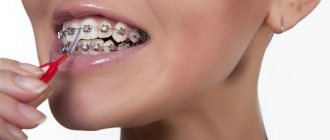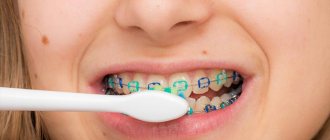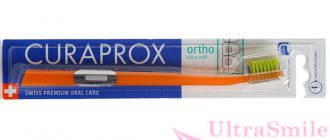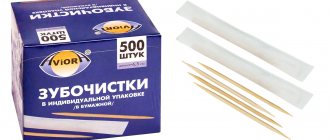Choosing the right hygiene products: review of brush models and rules for their use
Most people associate daily dental hygiene with a tube of toothpaste and a toothbrush. If the brush is chosen correctly and the teeth are straight, these items are usually enough. However, such cases are actually rare; uneven interdental spaces, dentures or braces and other deviations from the standard require more careful oral hygiene. One of the devices that provide such care are brushes for cleaning teeth. As experts note, this is truly one of the most important devices.
Instructions for use
The device is very simple to use. The following rules must be followed:
- Brush your teeth and rinse your mouth.
- Rinse the product well.
- It is used without the use of toothpaste and tooth powder.
- Bring the device to the area to be cleaned.
- Holding the brush perpendicular to the surface being treated, carefully (without pressing) insert it into the interdental gap. Dentists recommend performing circular or reciprocating movements (you cannot move it up and down like a floss).
- It should easily and completely pass through the gap and emerge from the inside. If it is difficult to pass, it must be replaced with another one of smaller diameter.
- Remove the brush and rinse under running water.
- Bring it to the next gap and repeat the insertion as well (then clean all interdental spaces one by one).
- During the procedure, you should periodically rinse your mouth.
- After cleaning is completed, rinse the device with running water, dry it and close it with the cap supplied.
Periodically, the product must be replaced with a new one . An indicator for its replacement is the loss of stiffness and shape of the villi (depending on the model, this should be done 2-3 times a month).
The first few days of use are conventionally called the adaptation period, during which slight bleeding of the gums may be observed. Mouth rinses can cope with it.
If the bleeding is severe, inflammation or toothache occurs, you should stop brushing. The main reason for the development of this condition is an incorrectly selected brush. It is necessary to consult a doctor to select the optimal model.
Dental brush - what kind of device is it?
A dental hygienic brush for teeth is a thin rod-shaped base along which nylon bristles, or villi, are located. The bristles can be densely or sparsely spaced, have different lengths and thicknesses, and be hard or soft.
The brush nozzle itself is equipped with a handle holder, which can also have different sizes. Manufacturers make handles from different materials, but they are all easy to use, non-slip, and hypoallergenic. Look at the photo below - you will immediately understand what product we are talking about.
What is this
A dental brush is a special device that allows you to clean out food debris from between your teeth. In appearance, it resembles an ordinary household brush, reduced significantly.
The product consists of 2 parts:
- handle holder;
- working part (the brush itself).
There are many variants available. Between themselves, they depend on the size, hardness, density and length of the bristles, the material from which the rod for attaching the bristles is made, and the diameter of the working surface.
The brushes are suitable for daily use, easy to use, efficiently clean hard-to-reach areas, do not injure the mucous membranes, and are suitable for caring for healthy and affected areas. This is an ideal device for keeping your mouth clean when wearing implants, braces, and crowns.
A short video review of dental brushes can be seen in this video:
In what cases should this product be used?
It is recommended to use a dental brush in the following situations:
- requires more thorough oral hygiene than a toothbrush and even dental floss can provide,
- under normal conditions, the back surface of the dentition is poorly cleaned,
- pieces of food get stuck between the teeth, which cannot be removed using conventional methods (rinsing or brushing),
- a bracket system is installed on the dentition, the elements of which require better care,
- Plaque often accumulates on the enamel, and ordinary cleaning cannot cope with it.
If you find yourself with such problems, anyone can buy a brush for brushing their teeth and improve the quality of their oral hygiene.
“In addition to preventive and general recommendations for use, the products also have medical indications. For example, they must be used if braces are installed, if there are pathological changes in periodontal tissues. They are also indicated in the presence of crowding of dentition units or, on the contrary, in case of significant interdental spaces. In addition, the dentist may advise you to use a brush if you smoke, drink a lot of coffee or black tea, or often consume products with dyes - the device helps not only remove plaque from the enamel, but also prevent its staining,” says the expert, dental therapist Uspangalieva Nina Borisovna.
Tools for caring for braces
Devices for caring for the oral cavity during orthodontic treatment may seem strange and uncomfortable at first glance, but they are not. If you are interested in where in Moscow you can buy an orthodontic toothbrush and brushes for cleaning braces, then just ask your dentist or search on the Internet. Today, most pharmacies and a large number of online stores offer a full range of hygiene products for patients undergoing orthodontic treatment. Moreover, the prices for these tools can vary, both from quite high for products of professional dental brands (for example, toothbrushes and brushes for Curaprox braces), and to absolutely affordable brushes from mass market brands (toothbrushes and brushes for Oral braces B (oral bi).
How does the device work?
The principle of operation is based on the ability of the villi to penetrate into the most inaccessible places in the dentition, ensuring the cleaning of each individual tooth from all sides. Thin, but hard and dense bristles can remove even pigmented plaque (but not stone, of course).
The wire on which the villi are located is highly flexible, which makes it possible to clean remote areas of the oral cavity. A mild mechanical effect on the enamel acts as an abrasive (especially when smoking or drinking coffee), creating a whitening effect.
Varieties
You can find many types of products on sale. They differ in shape and purpose. The classification of interdental brushes is shown in the table.
| Form | Description |
| Curved | The semicircle shaped handle is combined with a rod. These brushes are great for braces. Thanks to their semicircular shape, they easily remove plaque that accumulates in hard-to-reach places. Curved brushes are the most expensive |
| Cylindrical | The peculiarity is the same length of the fibers. This brush is used as an additional care for gums, in addition to a brush, and also to remove contaminants from the oral cavity. The device is suitable for installing an implant, since with the help of fibers of the same length you can remove dirt in hard-to-reach places. This is the prevention of periodontal disease. These brushes are considered convenient, and they are cheaper than others. |
| Cone-shaped | The bristles are arranged in a cone shape. The longest villi are at the base, and the shortest ones are at the end. This form is recommended for people who have the correct structure and an even row of teeth. The price of these products is average. |
What types are there
There are three types of hygienic devices:
- cylindrical: have the same length of bristles throughout the base; They cope well with food stuck between teeth and help prevent periodontitis due to the high-quality removal of plaque from narrow spaces. Quite inexpensive and ubiquitous
- in the form of a cone: as you move towards the tip of the brush, the bristles become shorter, which makes it possible to penetrate deeper into interdental crevices of different sizes. They cost more than the previous option,
- curved: great for people who have braces installed, as they allow you to clean areas that are inaccessible to a regular brush (for example, under the clasps of braces, in the spaces between crowns, and so on). The cost is higher than other models.
What to look for when choosing
Manufacturers produce brushes for brushing teeth in different versions, so the question arises - how to choose the right one and what to pay attention to. When purchasing, it is extremely important to consider the following product characteristics:
- length of the device: a shorter one, marked S, is suitable for children, and a brush marked XL is preferable for adults; In addition, there are intermediate options,
- lint length: this parameter determines how good the cleaning will be; if there are large gaps between the teeth, you should choose a product with long bristles (at least three millimeters), with densely spaced units of the dentition you need bristles about 1-3 mm long,
- stiffness of the bristles: selected depending on the sensitivity of the gums and enamel layer - if it is high, bleeding gums are observed, the choice should be made in favor of soft bristles; in other cases, it is enough to purchase a product with medium-hard bristles,
- material: the main rod to which the bristles are attached can be metal or plastic; If the dentition is in perfect order, dentists recommend purchasing products with a metal rod; if you have high sensitivity of the enamel layer and dental problems, it is better to opt for plastic models.
It is important to know! In general, when choosing a product, you should focus on the individual characteristics of the anatomy of the jaws, the presence or absence of bridges, implants, braces and other nuances. Before purchasing, it is advisable to talk to your dentist to get professional recommendations. Remember that brushes are strictly prohibited when any prosthetic structures (crowns, bridges, etc.) and dental implants are installed in the mouth!
Selection rules
When purchasing a brush, you should pay attention to the following parameters:
- The length of the device itself .
There are 5 sizes available, and the optimal length is selected based on age. Thus, for children, a product with the shortest working part (designated S) is recommended. The maximum size is designated XL. Advice: it is very difficult to determine on your own exactly how long a brush is required. It is best to do this together with a doctor: after measuring the interdental distance, he will determine the desired size. - Villi length . Here you should focus on the size of the interdental space. Thus, for crowded units, it is recommended to use models with short villi (1 mm), and for trema and diastemas - with a length of 3 mm or more. It is also necessary to take into account the presence of orthodontic structures, implants and dentures. Products with short bristles are best for cleaning.
- Villi hardness . The devices are available with 2 types of bristles: soft and medium hard. Soft ones are approved for use for children, for periodontal hypersensitivity and for cleaning implants.
- The material from which the rod for attaching the bristles is made. Plastic or metal is used to make it. For weak and inflamed periodontal tissue, dentists recommend a brush with a plastic rod, since it is elastic and does not injure the mucous membrane and soft tissues.
- Handle length . This parameter is associated with the individual preferences of patients, i.e. whoever is more comfortable. Many manufacturers add stops, protrusions and rings to the handle, making it more comfortable.
Tip: a device with a smooth handle is difficult to hold in your hand when cleaning, so it is better to give preference to models with protrusions or stops on the handle.
We must not forget about quality. Your choice should be made on products from well-known global manufacturers who have proven themselves to be positive over the years.
How to use the product – with and without braces
How to use a dental brush correctly? The algorithm of actions is as follows:
- select and install the desired attachment on the holder,
- place the brush near the dentition at an angle of 90˚ relative to the front surface of the teeth,
- carefully insert the product into the space between the teeth so that its tip appears on the opposite surface,
- clean the interdental space by rotating the brush or moving it back and forth,
- do the same with the next gap,
- After cleaning, rinse your mouth with water or mouthwash.
You should brush your teeth with braces according to the same procedure, only you first need to clean the parts of the braces system, and then proceed to hygiene of the interdental space.
Rules for using the product
How to properly brush your teeth with brushes to get the desired effect, but at the same time, not harm your gums and enamel? During the hygiene process, you need to pay attention to the following points:
- before using a new brush, you need to treat it with an antiseptic solution: you can also boil it for 2-3 minutes if it is made of hard plastic, or treat it with a UV lamp,
- the nozzle should be changed at least once every 7-10 days,
- you need to brush your teeth with a brush without paste or powder,
- bleeding gums in the first 1-3 days after starting to use the product is a normal phenomenon that goes away on its own,
- Do not move up and down when cleaning,
- the device is not used to clean the incisors of both jaws,
- if the product does not fit well into the space between the teeth, you need to change the nozzle: choose a shorter bristles size,
- procedure duration 2 minutes,
- when inserting the rod between the teeth and during the cleaning process, you should not put additional pressure on the brush for a “better” effect: this risks damaging the enamel layer,
- You need to use the device twice a day,
- After the procedure is completed, the product is washed with water, treated with an antiseptic, and dried.
In addition, the quality of hygiene is also affected by the cost of the device - cheap models, as a rule, are made of low-grade materials that quickly become deformed and become unusable.
Review of the best manufacturers
Despite the fact that dental brushes are a relatively young invention, they are gaining popularity among consumers. Therefore, many companies are engaged in the production of this device. The most popular of them are manufacturers specializing in oral hygiene products: Colgate, Oral-b, Lacalut, President, Curaprox and others. To understand which company is better to give preference, consider the rating of high-quality popular models and manufacturers in 2022.
Oral-B Interdental Starter Kit
This is perhaps the most famous company for the production of oral products. The line of interdental brushes includes: replaceable brushes for teeth, holders, and kits. A similar kit is the Oral-B Interdental Starter Kit. This is the perfect starter kit that includes:
- interdental brush holder;
- replaceable cylindrical nozzle;
- replaceable conical nozzle.
Using a cylindrical nozzle, you can easily remove food debris in wide gaps between teeth, around braces, bridges, and implants. The conical nozzle will cope with narrow and hard-to-reach places, ensuring the oral cavity is perfectly clean and healthy.
The ergonomic handle holder has a stylish design and fits comfortably in the hand, allowing you to manipulate the brush accurately and easily. Another advantage of such a pen is reusable use. In fact, you should buy such a set only once, and then only change the attachments, which are sold as a separate set, usually 6 pieces each.
Characteristics:
| Brush length | 18.5 cm |
| Diameter of cylindrical brush | 3 mm - 6.5 mm |
| Conical brush diameter | 2.7 mm |
| Length of brushes | 2.5 cm |
The cost of the set is 250₽
Oral-B Interdental Starter Kit
Advantages:
- a good starter kit with the necessary equipment;
- 2 replaceable nozzles of different shapes;
- suitable for cleaning bracket systems;
- convenient handle holder;
- affordable price.
Flaws:
- rapid wear of nozzles;
- Not suitable for very narrow gaps between teeth.
Colgate Total dental brush (2, 4, 5 mm)
This set from the well-known company Colgate Total will help keep both interdental spaces and orthodontic structures clean. Thanks to a set of three nozzles with different diameters of bristles, you can easily clean the necessary elements of the oral cavity:
- A nozzle with a diameter of 2 mm is suitable for cleaning between teeth;
- The 4 and 5 mm nozzle will do an excellent job of cleaning braces, bridges, and dentures.
The line of similar products also includes a set of 3 identical brushes, 2 mm in diameter.
The brush has a conical shape. The set includes 3 attachments with a small plastic handle and a removable handle holder. The handle with a brush is made in the shape of a curved drop, which is convenient to grasp with your thumb and forefinger. It can be used without an additional holder, or combined with it for easy cleaning of distant teeth and structures.
The plastic body of the holder also acts as a storage container. To do this, you just need to place the brush with the head inward. This makes it more compact and can easily fit in a purse or pocket. This set is convenient to take with you to a visit, cafe or restaurant, where it is not possible to brush your teeth immediately after eating. After all, to remove food debris, for example, in a braces system, it is enough to have a brush and warm water.
Average price — 220₽
Colgate Total Dental Brush (2, 4, 5 mm)
Advantages:
- compactness;
- good equipment;
- 3 nozzles of different diameters;
- suitable for cleaning braces and other structures;
- with non-slip handle;
- folding mechanism;
- convenient for use outside the home;
- budget price.
Flaws:
- The wire with bristles bends easily and becomes unusable.
Lacalut Interdental dental brush
The German company Lacalut, specializing in the production of oral hygiene products, has won the trust of not only ordinary consumers, but also dentists. In addition to toothpastes, brushes, rinses, dental floss and other things, the company also produces interdental brushes.
The line includes 4 sets of different diameters (from 2 to 4 mm) of 5 pieces each. The bristles are made of high-quality nylon, which are attached to a wire made of a special surgical alloy coated with insulating plastic. This combination helps eliminate contact with metal crowns to avoid discomfort and electrostatic discharge.
Cylindrical brushes are attached to a small, permanent plastic handle. Also included is a transparent cap that can be attached to the back of the handle, thereby extending it for use in hard-to-reach places.
The diameter of the bristles should be selected depending on the purpose of use. Sizes XS and S are suitable for cleaning interdental spaces. M and L are in demand among people with braces. Some people prefer to use several kits at once to achieve ideal oral cleanliness.
Characteristics:
| Size | Diameter |
| XS | 2 mm |
| S | 2.4 mm |
| M | 3 mm |
| L | 4 mm |
Set price — 350₽
Lacalut Interdental dental brush
Advantages:
- effectively removes plaque and food debris;
- choice of bristle diameter;
- suitable for bracket systems;
- 5 pieces per pack;
- cap holder.
Flaws:
- rapid wear;
- inconvenient removable handle.
Travel set of interdental brushes Curaprox CPS 457
This set of brushes from Curaprox includes:
- handle holder;
- 4 removable brushes of different diameters;
- travel case
The handle is made of high-quality non-slip plastic with an ergonomic shape for easy maneuvering in the most difficult to reach places. Fastening with the nozzle occurs with a click, which allows you to securely fasten the structural elements.
Nylon bristles, attached to a wire with a medical alloy, are coated with silicone, which allows you to effectively clean plaque and food debris without injuring your gums.
The travel case has ventilation holes, preventing bacteria from growing in a humid environment. There are compartments for all the attachments included in the kit, allowing you to take it with you while traveling.
Characteristics of nozzles:
| Nozzle | Bristle diameter |
| CPS 06 | 2.2 mm |
| CPS 07 | 2.5 mm |
| CPS 09 | 4 mm |
| CPS 11 | 5 mm |
Price — 900₽
Travel set of interdental brushes Curaprox CPS 457
Advantages:
- effective and non-traumatic cleansing;
- high quality materials;
- 4 different nozzles;
- removable ergonomic handle;
- travel case;
- stylish design.
Flaws:
- high price.
Interdental brushes PresiDent Soft sticks
PresiDent brushes are popular not only among wearers of braces, crowns and bridges, but also among those who carefully monitor oral hygiene. The finest S-size bristles, somewhat reminiscent of toothpicks, will penetrate into the narrowest crevice of the interdental space. The XL size will help you easily cope with dirt around orthodontic structures.
Soft sticks brushes do not contain metal, so you can easily use them without fear of electric shock when coming into contact with metal elements.
The level of stiffness of the bristles is low, so they gently massage the gums, removing plaque and bacteria around them.
Despite the fact that these “toothpicks” are very small and fragile, the package lasts a long time, because it contains as many as 20 pieces. The set includes a mini-container for storage and transportation.
Characteristics:
| Size | Diameter |
| Size S | 1.5-3.5 mm |
| Size XS | 2.5-4.5 mm |
Price — 350₽
Interdental brushes PresiDent Soft sticks
Advantages:
- compact;
- suitable for narrow gaps between teeth;
- do not contain metal;
- inexpensive in relation to 1 piece.
Flaws:
- quickly become unusable;
- short handle holder.
Dental brushes ROCS Minis
The well-known American company ROCS produces a wide range of oral hygiene products for both children and adults. Dental brushes are no exception.
This set consists of 10 identical replacement brushes. Made using special technology with polishing bristles, which allow you to gently and effectively remove dark stains and deposits from tobacco and coffee. Also excellent for cleaning any orthodontic and orthopedic installations in the oral cavity. The diameter of the bristles is 4 mm.
Average price — 260₽
Dental brushes ROCS Minis
Advantages:
- effectively clean interdental spaces;
- suitable for cleaning bracket systems;
- 10 pieces per pack;
- affordable price.
Flaws:
- not suitable for narrow interdental spaces.
Plackers Interdental Mix dental brush
This is a great starter kit for figuring out what size brush is right for you. This set contains 6 brushes of different diameters from 0.4 mm to 1.1 mm. Best suited for braces wearers. Perhaps they will need all types of brushes to perfectly clean all areas of the structure and the teeth between it.
A movable flexible rod on a long plastic handle allows you to thoroughly clean not only the front teeth, but also the back ones. The bristles are made of soft but durable synthetic material, ensuring gentle cleansing of the entire oral cavity. The bright multi-colored design will add mood when using it, and the presence of a cap will allow you to take the necessary brush with you into your purse.
Bristle diameter: 0.4 mm; 0.45 mm; 0.6 mm; 0.7 mm; 0.8 mm and 1.1 mm.
The price of the set is 250 rubles.
Plackers Interdental Mix dental brush
Advantages:
- the ability to choose the right size;
- convenient for cleaning braces;
- flexible movable brush head;
- comfortable plastic handle;
- protective cap;
- budget price.
Flaws:
- presence of only one cap;
- difficult to find on sale.
Where can I purchase the product and what is its cost?
Devices for cleaning teeth are sold in pharmacy chains, online stores, dental clinics, and relevant departments of supermarkets. Usually these are sets that can contain both models with non-removable holders, as well as removable and several attachments. The set may also contain brushes of different sizes and shapes, and the price of the set depends both on the characteristics of the products included in it and on the manufacturer’s brand. The cost of a set of brushes can range from 200 to 1,500 rubles and more.
“I buy Lakalut in our hypermarket; five pieces in a package cost only 300 rubles. Enough for more than a month. Cleans great..."
Angela L. (from a message from the stomatologclub.ru forum)
Advantages compared to other devices
The product has a number of advantages compared to floss, toothpicks and other oral hygiene items. Most often, users point to the following positive aspects:
- cheaper than an irrigator, with almost the same effect,
- Great for cleaning teeth with braces,
- if there are interdental spaces of different sizes, you can use different attachments of the product,
- They clean the bases of teeth well, especially the chewing group: these areas cannot be cleaned efficiently with conventional devices,
- promote visual whitening of enamel, preventing the accumulation of pigment in it,
- suitable for children.
In addition, brushes massage the gums, improving blood flow in them, thus preventing the development of many dental diseases.
Review of the most popular products
Which brushes are best for teeth? Below is a brief overview of the most popular brands, created based on reviews from online users.
LACALUT
LACALUT products are distinguished by the material they are made of - this is a special mass used for the production of surgical instruments. Great for cleaning teeth with braces. The protective cap can be used to extend the holder. Cost – 230-420 rubles.
CURAPROX
The manufacturer has tried to produce models for any purpose: simple teeth cleaning, with braces. The line includes products of different configurations and sizes. Can be used both for self-care of the oral cavity and for professional hygiene. Cost – 800-2000 rubles.
Plackers Interdental Mix
This set is perfect for a beginner – it contains products with different sized attachments. The rod is flexible and the holder is quite long. The kit includes a protective cap. Cost – 240-300 rubles.
PresiDENT
PresiDENT models are distinguished by their curved shape, comfortable holder, and compact size. They are mainly intended for people whose dentition is very dense and the spaces between the teeth are narrow. Cost – 240-480 rubles.
Oral-B
Products of this brand are also presented in a wide variety - brushes in the form of cones, cylindrical shapes, equipped with durable and convenient removable holders are available for sale. A plus is the presence of a hygienic storage container. Cost – 320-550 rubles.
Colgate
The company produces products for all occasions, having a variety of shapes and sizes of bristles and holder. High hygiene efficiency with Colgate brushes is achieved thanks to the triangular cross-section of the bristles. Cost – 350-650 rubles.
Purchasing and using a dental brush will significantly improve the quality of hygiene and improve the condition of the oral cavity. However, it is worth remembering that this product does not replace a regular toothbrush and toothpaste. Moreover, only comprehensive use of dental hygiene products will help maintain their health for many years.
Additional activities after cleaning
In addition to directly brushing teeth during orthodontic treatment, some other manipulations may be required to improve the patient’s quality of life - this is rinsing the mouth and working with wax.
Mouthwash
Dentists recommend using mouthwash daily. This allows you to quickly freshen your breath, while chewing gum remains an unaffordable luxury for patients with braces.
In addition, regular rinsing of the mouth with antiseptic solutions helps relieve inflammation, which especially often makes itself felt in the first days of wearing braces.
Why do you need wax?
If you buy a set for cleaning braces, then in the vast majority of cases it will also contain wax in addition to the already familiar listed tools. Why is it needed?
It is no secret that the sharp edges of braces and even the arch can cause microtrauma to the mucous membrane of the tongue, lips and cheeks. This is especially noticeable in the first 2-3 weeks of wearing braces, when all the known shortcomings of this orthodontic system are maximally manifested.
To avoid the formation of wounds, bleeding and generally improve the patient’s quality of life and increase his loyalty to treatment, orthodontists recommend the active use of wax. A small amount of it must be kneaded in your hands and applied to the part of the bracket with sharp edges. Gradually, this will no longer be necessary, as the oral mucosa adapts to the structure on the teeth.
Why brushes cannot be used with implants and dentures
Some, even well-known manufacturers of dental brushes, indicate in the instructions that their products can be used with dentures, crowns, and implants. But this is just an advertising ploy to expand the customer base. In fact, implantologists are categorically against it, because Gums after prosthetics partially lose sensitivity. Therefore, it is enough to simply damage them with villi (even seemingly soft ones) and cause an infection - and then treat complications. Therefore, it is also prohibited to use toothpicks. And for patients with dentures and implants, it is better to give preference to an irrigator for washing the interdental spaces and subprosthetic space, or choose dental floss labeled “super floss” - the rest will not be suitable, since they are quite hard.










